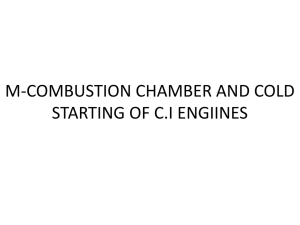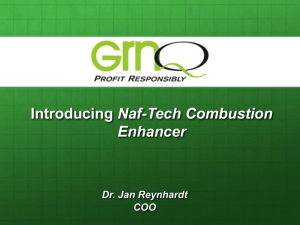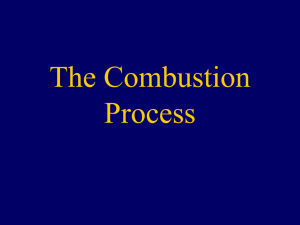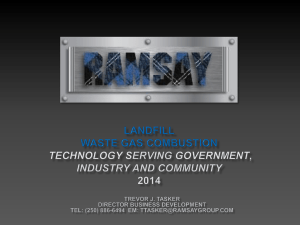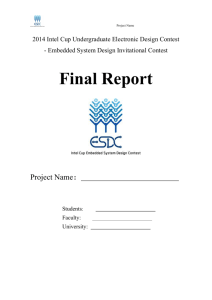Outline - Energimyndigheten
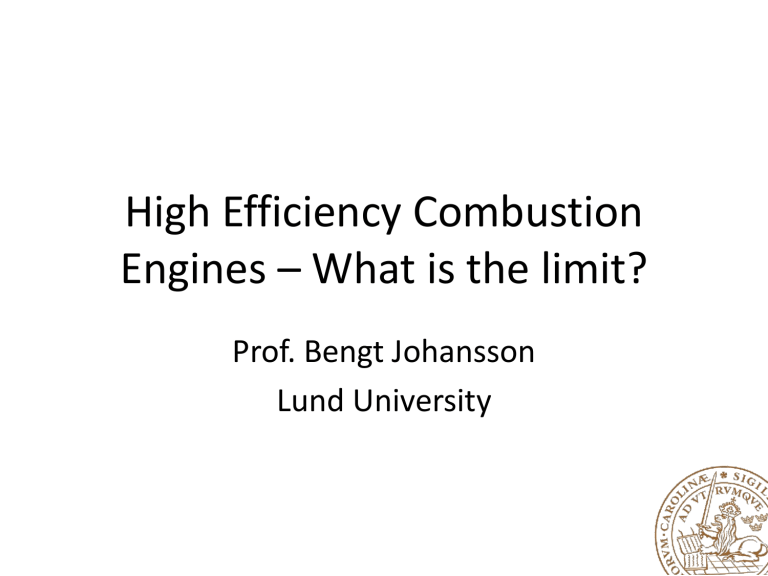
High Efficiency Combustion
Engines – What is the limit?
Prof. Bengt Johansson
Lund University
Outline
• Introduction
• The future is hard to predict
• Options
• Other combustion engines?
• Fuel cells?
• Batteries?
• Combustion engines
• What is high efficiency?
• Combustion, thermodynamic, gas exchange and mechanical efficiencies. All four must be high.
• What options do we have?
• Combustion to enable high efficiency
• Spark Ignition
• Compression Ignition
• HCCI
• Partially Premixed Combustion
• Can we do something about engine design?
• Conclusions
Today
100.0% of all cars and trucks have
internal combustion engines
The total fleet is about 1.000.000.000 cars and trucks
The electric fleet is less an 1.000.000 i.e. 0.1%
“Prediction is very difficult especially if it is about the future”- Niels Bohr http://wattsupwiththat.com/2014/07/27/prediction-is-very-difficult-especially-about-the-future/
Newsweek April 28, 1975
5
”Den som ser framåt utan att se bakåt får se upp” -
Per Gillbrand
Car of the future 1950-60: Gas turbine
Car of the future 1950-60: Gas turbine
“Timetable for Next Car Engine : The Gas
Turbine and Its Future” Business Week, April 2,
1955, page 134+
THEY ESTIMATE by
1960 .................60,000 - 300,000 cars
1965 ................264,000 - 3,900,000
1970 .............11,500,000 - 42,500,000
1975 .............48,000,000 - 62,000,000 http://fuel-efficient-vehicles.org/energy-news/?page_id=943
Car of the future 1970: Stirling
Car of the future 1980: ….
Car of the future 1990: Battery Electric
GM EV-1
Car of the future 2000: Fuel Cell
Car of the future 2000: Fuel Cell
“It is generally accepted that fuel cell vehicle production will follow a timeline as follows:
Starting in 2002-4:
• First production FCVs tested on public roads in US, Europe and Japan in demonstration fleets.
Around 2006-2007
• Second generation fuel cell systems incorporated into FCVs and the expansion of FCV fleets in the US, Europe and Japan.
Starting in 2010
• Marketing of commercially viable FCVs at affordable prices - this will be the first step toward ultimately replacing the conventional internal combustion engine models.”
August 29, 2002, Bloomberg News :
”Larry Burns, GM’s vice-president for R&D: “GM’s goal is to be the world’s first company to produce one million fuel cell vehicles a year,” and that GM is looking to sell hundreds of thousands of fuel cell vehicles between 2010 and 2020 http://www.engr.uconn.edu/~jmfent/AutoCompaniesonFuelCells.pdf
Car of the future 2010: Battery Electric
Carlos Ghosn CEO Renault/Nissan 2010: “Nissan Will Sell 500,000 Electric Cars a Year by 2013”
He predicted that 10 percent of the world car market would be electric vehicles by 2020.
“There is no doubt in the minds of anyone in the industry that this is going to be a big factor in the industry,” he said.
Car of the future 2010: Battery Electric
Reuters news flash Sept 14 2014:
Nissan faces battery plant cuts as electric car hopes fade
Ghosn dropped extra battery sites planned for both alliance carmakers, leaving Nissan with the entire production capacity of
220,000 power packs through the
NEC joint venture, AESC.
But that still far exceeds the
67,000 electric cars Renault-
Nissan sold last year, and even the 176,000 registered to date. A pledge to reach 1.5 million by
2016 has been scrapped.
Toyota: Elbilen behöver Nobelprisbatteri
Tekniken som behövs för att göra elbilar användbara är inte uppfunnen än
- Körsträckan är så kort med en elbil, och laddtiden
är så lång, summerar Kato. Med den tekniknivå vi befinner oss på i dag behöver någon uppfinna ett batteri så bra att det vinner Nobelpris.
För att kunna konkurrera med dagens bensindrivna bilar behövs så mycket batterier att det ökar kostnaderna och laddtiderna.
- Antalet kunder som är nöjda med elbilens korta räckvidd är begränsad, säger han. Men blir intresset för sådana bilar plötsligt större, då är vi beredda att leverera.
Av: Håkan Abrahamson, Ny teknik 10 juli 2014
16
Toyota: Elbilen behöver Nobelprisbatteri
I en intervju i Automotive News ger han tummen ner för satsningen på elbilar, och säger att Toyota nu lägger sin tillverkning av elbilar.
Företaget tror att alternativet till bensin och diesel heter vätgas. Nästa år lanserar Toyota en
bränslecellbil, och även andra tillverkare ligger startgroparna med den sortens drivning.
- Vid det laget erbjuder Toyota inte längre någon helt eldriven bil, säger Kato. De små serier av elbilar som nu finns på programmet, minibilen eQ och RAV4 EV, läggs ner i slutet av det här året.
Av: Håkan Abrahamson, Ny teknik 10 juli 2014
17
Battery performance
“The active material for the anode and the cathode which are assumed to be a carbon-based anode (~2.7 g/Ah) and a Co-based cathode (~7.3 g /Ah) for the Li-ion cell.
The specific capacity of the couple is therefore
~100 Ah/kg which combined with the voltage of 3.85
V for this couple leads to the 385
Wh/kg number”
Source: Private communications with Prabhakar Patil, CEO, LG
Chem, Battery Div. Nov. 4, 2011
18
Li-ion battery performance is now at
52% of theoretical limit
40/250=0,160
55/245=0,225
55/315=0,175
70/370=0,189
80/240=0,333
20/810=0,025
20/135=0,148
70/570=0,123
180/790=0,228
130/459=0,283
200/385=0,519
Source: Private communications with Prabhakar Patil, CEO, LG
Chem, Battery Div. Nov. 3, 2011
19
Electric Vehicle – Storage capacity
900
800
700
600
500
ZMP
Ag-Zn
400
Li-Ion
300
200
Ni-
MH
200 years
Ni-
Cd 100 Lead-
Acid
0
0 50 100 150 200 250
Specific Energy (Wh/kg)
Even a low efficient ICE will have a better energy density and specific energy under normal running conditions.
300
For the same rated power an electric vehicle is much heavier than a ICE.
Cost of batteries!
350
Energy density increased 1 order of magnitude
Specific energy increased a factor of 4-5
Source: Tarascon and D. Foster Keynote speech at ASME ICES 2009
20 20
Electric Vehicle – Electricity source?
Q: What is the similarity of a steam engine and a battery electric vehicle?
A: They both run on coal…
21 www.cameco.com
Summary on alternatives
• They have all promised much but delivered little!
• There is today not a viable alternative to the
Internal Combustion Engine
• We must focus our little resources to improve what will be the prime mover of the future, not unrealistic scenarios
• The ICE can be improved very much in the future
22
Car of the future, today
• Smaller car with small ICE in combination with hybrid system. Fuel consumption of 0.67-1 l/100km (<25 g/km CO2)
• ICE 60% fuel efficient with below zero levels of local emissions like
NOx, PM, HC and CO. The 40% heat loss is used for heating the car.
• At least 100% CO2-neutral with renewable fuel
Car of the future, in the future
Car of the future, the Crystal Ball?
German architect André Broessel of Rawlemon
Outline
• Introduction
• The future is hard to predict
• Options
• Other combustion engines?
• Fuel cells?
• Batteries?
• Combustion engines
• What is high efficiency?
• Combustion, thermodynamic, gas exchange and mechanical efficiencies. All four must be high.
• What options do we have?
• Combustion to enable high efficiency
• Spark Ignition
• Compression Ignition
• HCCI
• Partially Premixed Combustion
• Can we do something about engine design?
• Conclusions
Energy flow in an IC engine
Brake
Combustion
*
Thermodyna mic
*
GasExchang e
*
Mechanical
+ Clean with 3-way
Catalyst
- Poor low & part load efficiency
Combustion modes
Spark Ignition (SI) engine (Gasoline, Otto)
+ High efficiency
- Emissions of NO x soot and
Compression Ignition
(CI) engine (Diesel)
+ High efficiency
+ Ultra low NO x
Homogeneous Charge
Compression Ignition
(HCCI)
-Combustion control
-Power density
Spark Assisted
Compression Ignition
(SACI)
Gasoline HCCI
+ Injection controlled
- Less emissions advantage
Partially premixed combustion (PPC)
Diesel HCCI
ICE research in Lund vs. time
CCV=Cycle to Cycle
Variations in
Spark Ignition
Engines
GDI= Gasoline Direct
Injection
2-S= Two Stroke engine
VVT=Variable Valve
Timing
HCCI=Homogeneous
Charge
Compression
Ignition
SACI=Spark Assisted
Compression
Ignition
PPC= Partially
Premixed
Combustion
1990 1995 2000 2005 2010 2015
29
Emission focus vs. time
1970 1980 1990 2000 2010 2020
30
HCCI -Thermodynamic efficiency
Saab SVC variable compression ratio, VCR, HCCI, Rc=10:1-30:1;
General Motors L850 “World engine”, HCCI, Rc=18:1, SI, Rc=18:1, SI, Rc=9.5:1 (std)
Scania D12 Heavy duty diesel engine, HCCI, Rc=18:1;
Fuel: US regular Gasoline
31
SAE2006-01-0205
All four efficiencies
SAE keynote Kyoto 2007
32
Net indicated efficiency= η
C
η
T
η
GE
+100%
SI std
SI high
HCCI
VCR
Scania
Brake efficiency
SI std
SI high
HCCI
VCR
Scania
Net indicated efficiency= η
C
η
T
η
GE
47%
SI std
SI high
HCCI
VCR
Scania
45
40
35
30
25
20
0
60
55
50
PPC - Diesel engine running on gasoline
HCCI: η i
=47% => PPC: η i
=57%
Group 3, 1300 [rpm]
2
FR47333CVX
FR47334CVX
FR47336CVX
4 6 8
Gross IMEP [bar]
10 12 14
36
Partially Premixed Combustion, PPC
Spridare 8x0.12x90 & 8x0.12x150, Iso-oktan, CR-tryck 750 bar, Duration 0,6 ms = 3.6 CAD
6000 1200
HCCI
PCCI CI
5000 PPC 1000
4000 800
3000
2000
1000
600
400
200
-180 -160 -140 -120 -100 -80
SOI [ATDC]
Def: region between truly homogeneous combustion, HCCI, and diffusion controlled combustion, diesel
37
SAE 2004-01-2990
Experimental setup, Scania D12
Bosch Common Rail
Prail max
Orifices
Orifice Diameter
Umbrella Angle
1600 [bar]
8 [-]
0.18
[mm]
120 [deg]
Engine / Dyno Spec
BMEPmax
Vd
Swirl ratio
15 [bar]
1951 [cm3]
2.9
[-]
Fuel: Gasoline or Ethanol
38
SAE 2009-01-2668
Efficiencies 17.1:1
39
100
95
90
85
80
75
70
65
60
55
50
4 5 6
Combustion Efficiency
Thermal Efficiency
Gas Exchange Efficiency
Mechanical Efficiency
7 8 9
Gross IMEP [bar]
10 11 12 13
39
SAE 2009-01-2668
Efficiencies 14.3:1
40
75
70
65
60
55
50
4
100
95
90
85
80
6
Combustion Efficiency
Thermal Efficiency
Gas Exchange Efficiency
Mechanical Efficiency
8 10 12
Gross IMEP [bar]
14 16 18
40
SAE 2010-01-0871
Emissions
0.6
0.3
0.2
0.1
0
2
0.6
0.5
0.4
0.3
1.5
Gross
Net
Brake
EU VI
US 10
4 6 8 10 12
Gross IMEP [bar]
14 16 18
1.2
Gross
Net
Brake
EU VI
US 10
0.9
0
2 4 6 8 10 12
Gross IMEP [bar]
14 16 18
41
10
9
8
7
6
5
1
0
2
4
3
2
1.2
1
0.8
0.6
0.4
0.2
2
1.8
1.6
1.4
0
4
Better tuned EGR-
combination
6 8 10 12
Gross IMEP [bar]
4 6 8
41
10 12
Gross IMEP [bar]
14
14
16
Gross
Net
Brake
EU VI
US 10
16
18
18
12
10
8
6
4
2
0.3
0.25
0.2
0.15
0.1
0.05
0.5
0.45
0.4
0.35
0
2 4 6
Emissions – different fuels
Ethanol
FR47330CVX
FR47331CVX
FR47333CVX
FR47334CVX
FR47335CVX
FR47336CVX
FR47338CVX
8 10 12
Gross IMEP [bar]
14 16 18 20
2.5
2
1.5
1
0.5
Ethanol
FR47330CVX
FR47331CVX
FR47333CVX
FR47334CVX
FR47335CVX
FR47336CVX
FR47338CVX
0
2
SAE 2010-01-0871
4
Ethanol
FR47330CVX
FR47331CVX
FR47333CVX
FR47334CVX
FR47335CVX
FR47336CVX
FR47338CVX
6 8 10 12
Gross IMEP [bar]
14 16 18 20
0
2 4 6 8 10 12
Gross IMEP [bar]
14 16 18 20
5
4
3
2
1
0
2
10
9
8
7
6
4 6 8 10
42
12
Gross IMEP [bar]
14
Ethanol
FR47330CVX
FR47331CVX
FR47333CVX
FR47334CVX
FR47335CVX
FR47336CVX
FR47338CVX
16 18 20
20
15
Tested Load Area
25
Stable operational load vs. fuel type
10
5
0
20 30 40 50 60
RON [-]
70 80 90 100
43
Efficiency with Diesel or Gasoline
Average improvement of 16.6% points at high load by replacing diesel fuel with gasoline!
52
50
D13 Gasoline
D13 Diesel
48
46
44
42
40
38
36
34
5 10 15 20
Gross IMEP [bar]
25
D13 Diesel was calibrated by Scania to meet EU V legislation.
30
44
PPC Combustion Summary
• PPC has shown very high fuel efficiency
– Indicated efficiency of 57% at 8 bar IMEP
– Indicated efficiency of 55% from 5-18 bar IMEP
• With 70 RON fuel we can operate all the way from idle to 26 bar IMEP
• Emissions are below US10/Euro 6 without aftertreatment for NOx, PM, HC and CO!
• The fuel properties are critical for PPC load range
45
ICE research in Lund vs. time
CCV=Cycle to Cycle
Variations in
Spark Ignition
Engines
GDI= Gasoline Direct
Injection
2-S= Two Stroke engine
VVT=Variable Valve
Timing
HCCI=Homogeneous
Charge
Compression
Ignition
SACI=Spark Assisted
Compression
Ignition
PPC= Partially
Premixed
Combustion
1990 1995 2000 2005 2010 2015
46
Energy flow in an IC engine
Brake
Combustion
*
✔ mic
*
✖ e
*
High efficiency thermodynamics:
Simulation results from GT-power
• Indicated efficiency 64%
• Brake efficiency 60.4%
• System layout is confidential
Outline
• Introduction
• The future is hard to predict
• Options
• Other combustion engines?
• Fuel cells?
• Batteries?
• Combustion engines
• What is high efficiency?
• Combustion, thermodynamic, gas exchange and mechanical efficiencies. All four must be high.
• What options do we have?
• Combustion to enable high efficiency
• Spark Ignition
• Compression Ignition
• HCCI
• Partially Premixed Combustion
• Can we do something about engine design?
• Conclusions
The future ICE
• Highest possible fuel efficiency
• Low enough emissions of NOx, PM, HC, CO
• Capable of using renewable fuels
And the basic requirements of all products:
• Very high durability
• Low service requirements
• High power/mass ratio
• High power/volume ratio
• Low cost
50
Future
• Optimize the combustion process
– PPC
– Diesel
– Spark Ignition (prechamber)
• Improve the thermodynamics
– A compression ratio,R h
(γ=1.38) gives a thermodynamic efficiency of 80%! c
T
=
1 of 70:1 and lean mixture
-
• Work with engine systems, not only details
1
R c g -
1
51
What is the long term future?
• Active rate shaping
– What is the best Rate of Heat Release, RoHR, for maximum thermodynamic efficiency?
– The analog fuel injector with real time control of fuel flow and hence RoHR (with short ignition delay) using FPGA
• Fuels and engine interactions
– Best fuel for a combustion process
– Fuel flexible combustion process
• Natural gas/Biogas
– LNG/LBG-intercooler
• Hybrids
– The 2, 4, 6 concept
– Air Hybrid
• Heat transfer, coatings etc.
52
High Efficiency Combustion
Engines – What is the limit?
“It all starts at 40 and ends at 60”
( %engine efficiency that is, not life)
Prof. Bengt Johansson
Lund University
Thank you!
54
High Efficiency Combustion
Engines – What is the limit?
Prof. Bengt Johansson
Lund University


